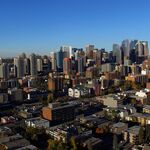This is great. Last year, the metro grew by about 11 000 total. With this new data on the City of Calgary, our metro is up around 16,100 this year, and extrapolating conservatively for Rocky View County and Irricana (which aren't doing censuses this year) combined, we can safely say that the metro has grown by about 17,000 total over the past year. This is in line with the average rate of growth for the Ottawa-Gatineau CMA over the past 5-6 years. That is pretty remarkable, considering we're in the midst of one of the worst recessions of our provincial history.
A breakdown...
Calgary - 11,166
Airdrie - 3,080
Cochrane - 1,198
Chestermere - 616
Crossfield - 72
Census Total - 16,132
Extrapolation for RVC and Irricana ~ 868
CMA total ~ 17,000
Further, extrapolating for Foothills MD and its constituent municipalities, none of which conducted censuses this year, we're probably looking at a total of about 20 000 for Greater Calgary.
Also of note, as of the 2016 federal census, Alberta Census Division 6 (Calgary) is now at a population of over 1,498,000, up 14.3% from the 2011 federal census. This is the largest numerical increase of any CD in the province (187,000), and also the highest rate of increase. At 12,646 KM2, CD6 now has a population density of 118.5/km2, this is the only CD in Alberta with a density above 100/km2. It includes: City of Calgary, Rocky View County, Mountainview County, and Foothills MD.
The Calgary CMA, as of the 2016 federal census, was at 1,392,609. At 5,107.55 km2, our population density was 272.7/km2 in 2016, on course to be over 300/km2 by census 2021.
Adding in the ~20,000 growth of Greater Calgary since the 2016 federal census, while subtracting the 35,000 of Mountainview County, gives us a population for Greater Calgary of 1,483,000. This indicates that we'll be surpassing the 1.5 million mark easily within the next two years, if not by next year. At 8,298.69 km2, Greater Calgary now has a population density of 179/km2. For comparison purposes, this is significantly higher than the Edmonton CMA at 1,321,000 and 9,438.86 km2 with a density of 140/km2.
Projecting conservatively, down to 10% from our recent 14.3% over the past 5 years, and the 12.9% we grew from 2006 to 2011, assuming we hover around 10% until 2031, we will come in at about 2,015,000 by census 2031, not bad for 15 years.
Keep in mind as well that the federal census does have a substantial undercount for high-growth regions. As the Calgary Region has the highest growth rate in the country, it is likely that in reality we are already over 1.5 million. It is pretty much a certainty that the CMA is actually over 1.4 million. I believe the Census Bureau will be releasing an adjusted census sheet (to make up for the undercount) in the next year or so, so that should make things more clear.
#EndNerdout




